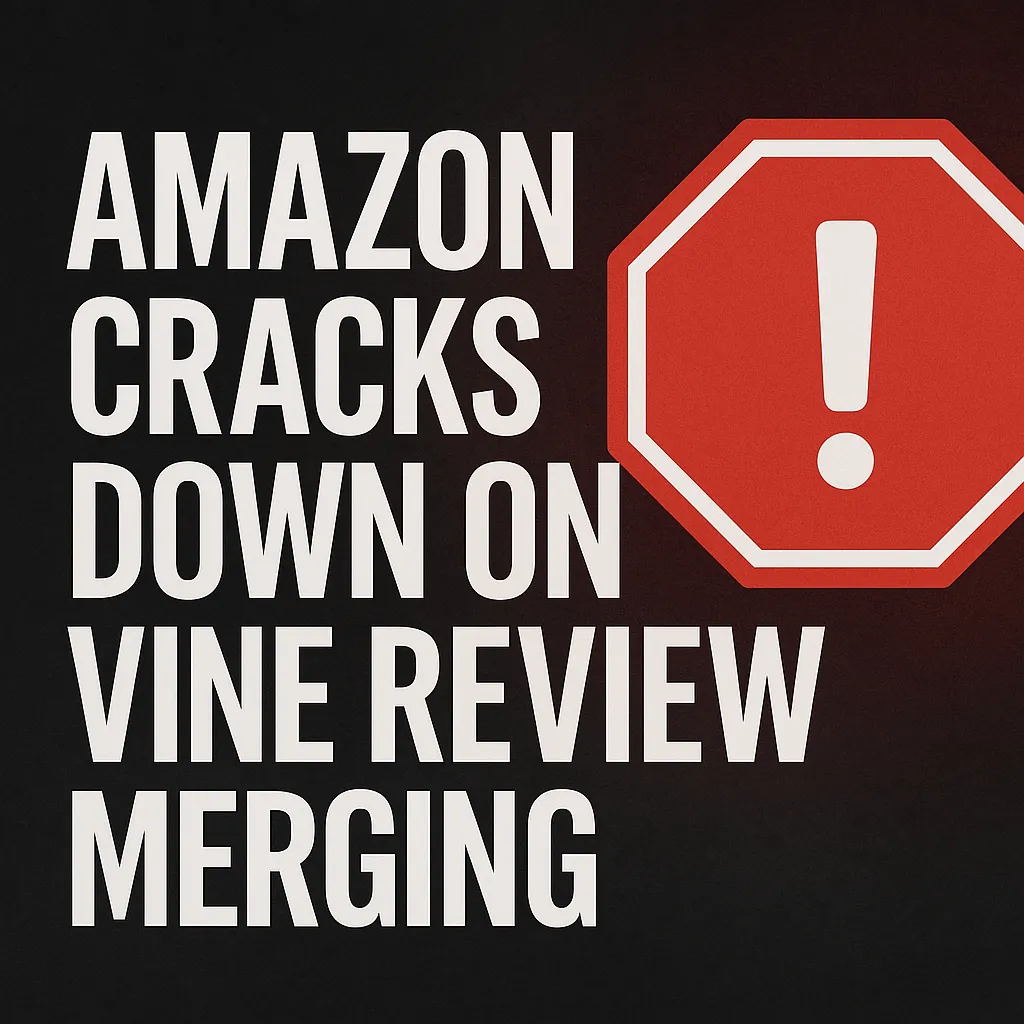Vine Review Merging: The Risk Sellers Don't See Coming
Vine Review Merging: The Risk Sellers Don't See Coming

Following widespread confusion and ongoing enforcement, Amazon has now released a formal clarification regarding Vine review aggregation and retention policies.
According to their updated documentation:
- Reviews are aggregated at the parent ASIN level, not at individual child ASINs.
- The number of Vine reviews displayed is capped based on your enrolment tier (2, 10, or 30 reviews depending on tier).
- If you merge ASINs after Vine reviews are collected, only the top-rated Vine reviews up to the limit will be retained. The rest will be dropped.
- Amazon now recommends enrolling all variations together from the start to avoid loss of reviews.
In other words, Vine review merging no longer results in combined review totals across ASINs – and attempting to do so may not only be ineffective, but also trigger enforcement if Amazon sees a pattern of review manipulation.
Amazon’s Vine program was created to help sellers generate early, authentic reviews from trusted reviewers. When used properly, it’s a powerful tool for new product launches. But recently, a subtle and seemingly innocent strategy involving Vine reviews and variation merges has started triggering serious enforcement from Amazon – leaving many sellers blindsided.
At ASA Compliance Group, we’ve been tracking a rise in account flags, suppressed listings, and review removals tied to this very tactic. The issue? Most sellers using it don’t realize they’re violating Amazon’s policies – because it feels completely valid. Let’s unpack the issue, the violation, and what a safer path looks like.
The process usually starts with a new variation – or a stand-alone ASIN – launched with a minor tweak to an existing product (different color, packaging, or quantity). Sellers enroll that ASIN in the Vine program to collect early reviews. Once 20-30 Vine reviews are secured, the ASIN is merged into a high-performing parent listing.
This strategy is tempting because it boosts the overall review count and often improves the listing’s average rating. The Vine reviews, although technically legitimate, get inherited by the parent listing. It looks like a win – but Amazon’s systems (and enforcement teams) are now actively flagging this as a form of review manipulation.
Why Amazon Is Cracking Down Amazon’s core concern is review attribution. Every review is supposed to represent the actual experience with a specific ASIN. When you shift reviews from one ASIN to another, even within a variation family, it creates a misleading narrative – especially when the merge is done primarily to aggregate reviews rather than represent true variation.
- Vine reviews that were originally posted for a specific ASIN are now appearing on a different product variation, confusing customers.
- If the merged ASINs aren’t truly different formats of the same product (e.g. not a legitimate size/color variant), Amazon sees it as a misuse of the variation structure.
- Amazon considers this tactic to be artificially inflating the star rating and credibility of a listing by introducing reviews from a separate product experience.
Most sellers caught in this trap didn’t act with deceptive intent – but in Amazon’s policy logic, intent doesn’t matter as much as outcome.
We’ve handled dozens of cases related to this tactic, and the fallout can range from mild to severe:
- Amazon silently unmerges the listing and removes the Vine reviews.
- Listings are suppressed due to detected review abuse or variation policy violations.
- Accounts receive performance notifications or warnings under the “Abuse of Ratings, Feedback, or Reviews” category.
- In rare but serious cases, sellers face ASIN-level suspensions – or even account reviews triggered by “pattern behavior.”
We’ve also seen sellers lose Vine review slots entirely after a misuse, meaning they can’t re-enroll future ASINs. That’s a painful, long-term hit to product launch strategy.
This issue tends to affect brands who do care about compliance. These aren’t black-hat sellers gaming the system – they’re established private label sellers, often advised by agencies or consultants who haven’t kept up with enforcement trends.
The bigger problem? This tactic is still being recommended in Facebook groups and course communities, which leads many sellers to believe it’s a smart “gray area” move. But once Amazon flags it, it’s no longer gray – it’s a clear violation.
What You Should Do Instead
If you want to use Vine and stay fully compliant, here’s how to protect yourself:
- Use Vine only for ASINs that will remain standalone or part of a variation family with valid justification. Don’t use Vine to collect reviews on a disposable ASIN with the plan to merge it later.
- If you must merge ASINs, make sure the products meet Amazon’s variation guidelines. Ask yourself: Would a customer expect these variations to share a review section? If not, don’t merge.
- Avoid review aggregation tactics entirely. Whether intentional or accidental, any strategy designed to shift reviews from one ASIN to another is a long-term risk.
- Document your variation structure choices. If enforcement hits, you’ll want to show that your merges were based on genuine product differences, not review benefits.
How to Fix It If You’ve Already Done It
If you’ve already used this tactic and Amazon hasn’t flagged you yet, now is the time to proactively fix it.
- Consider reversing the variation merge – detach the ASINs and allow each to stand alone with its earned reviews.
- If you’ve received a warning or notice, don’t panic – but don’t ignore it either. Craft a detailed, honest Plan of Action explaining what happened, how it was unintentional, and what changes you’ve made to ensure compliance moving forward.
- If Vine slots were misused, accept the consequences and reframe your launch strategy. It’s better to stay clean than risk deeper enforcement.
Final Thoughts
This issue isn’t about tricking Amazon. It’s about an enforcement shift that sellers haven’t fully caught up with. Vine review merging might look clever, but Amazon is watching it more closely than ever – and treating it as a violation of core trust principles.
At ASA Compliance Group, we specialize in guiding sellers through exactly these kinds of issues. If you’re unsure whether your variation strategy or Vine usage puts your account at risk, let’s talk. We’ve helped over 3,600 sellers recover and grow stronger – and we’re here to help you do the same.
Contact us to make sure your strategy is safe, sustainable, and built for the long haul.
